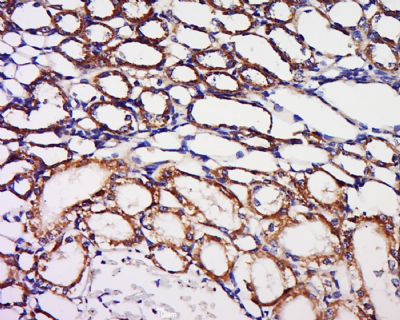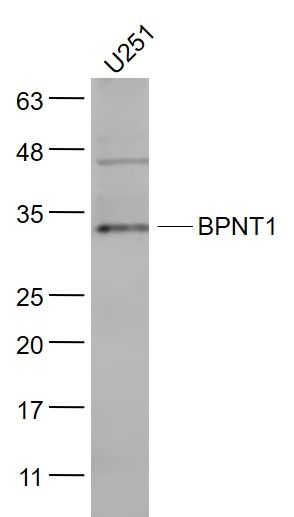BPNT1 Polyclonal Antibody
Purified Rabbit Polyclonal Antibody (Pab)
- 产品详情
- 实验流程
Application
| WB, IHC-P, IHC-F, IF, ICC, E |
|---|---|
| Primary Accession | O95861 |
| Reactivity | Rat, Bovine |
| Host | Rabbit |
| Clonality | Polyclonal |
| Calculated MW | 33392 Da |
| Physical State | Liquid |
| Immunogen | KLH conjugated synthetic peptide derived from human BPNT1 |
| Epitope Specificity | 2-100/308 |
| Isotype | IgG |
| Purity | affinity purified by Protein A |
| Buffer | Preservative: 0.02% Proclin300, Constituents: 1% BSA, 0.01M PBS, pH7.4. |
| SIMILARITY | Belongs to the inositol monophosphatase family. |
| Important Note | This product as supplied is intended for research use only, not for use in human, therapeutic or diagnostic applications. |
| Background Descriptions | BPNT1 is a member of the magnesium-dependent, lithium-sensitive phosphomonoesterase superfamily. Using magnesium as a cofactor, BPNT1 catalyzes the conversion of PAPS (adenosine 3’-phosphate 5’ phosphosulfate) to APS (adenosine 5’-phosphosulfate) and the conversion of PAP (3’(2’)-phosphoadenosine 5’ phosphate) to AMP (adenosine 5’-phosphate). Expressed ubiquitously with highest levels in brain and kidney, BPNT1 is potently inhibited by lithium, a drug used for the treatment of manic depression and bipolar affective disorder, suggesting a possible role for BPNT1 in the etiology of mood disorders. Inhibition of BPNT1 leads to an accumulation of PAP and subsequent inhibition of sulfotransferases which may result in changes in gene expression, changes in phosphatidylinositol second messenger function and/or changes in sulfation processes. |
| Gene ID | 10380 |
|---|---|
| Other Names | 3'(2'), 5'-bisphosphate nucleotidase 1, 3.1.3.7, Bisphosphate 3'-nucleotidase 1, PAP-inositol 1, 4-phosphatase, PIP, BPNT1 |
| Target/Specificity | Highly expressed in kidney, liver, pancreas and heart. Detected at lower levels in brain, placenta, lung and skeletal muscle. |
| Dilution | WB=1:500-2000,IHC-P=1:100-500,IHC-F=1:100-500,ICC=1:100-500,IF=1:100-500,ELISA=1:5000-10000 |
| Format | 0.01M TBS(pH7.4) with 1% BSA, 0.09% (W/V) sodium azide and 50% Glyce |
| Storage | Store at -20 °C for one year. Avoid repeated freeze/thaw cycles. When reconstituted in sterile pH 7.4 0.01M PBS or diluent of antibody the antibody is stable for at least two weeks at 2-4 °C. |
| Name | BPNT1 |
|---|---|
| Function | Phosphatase that converts 3'(2')-phosphoadenosine 5'- phosphate (PAP) to AMP and inositol 1,4-bisphosphate (Ins(1,4)P2) to inositol 4-phosphate (PubMed:10675562). Is also able to hydrolyze adenosine 3'-phosphate 5'-phosphosulfate (PAPS) to adenosine 5'- phosphosulfate (APS) (By similarity). Probably prevents the toxic accumulation of PAP, a compound which inhibits a variety of proteins, including PAPS-utilizing enzymes such as sulfotransferases, and RNA processing enzymes. Could also play a role in inositol recycling and phosphoinositide metabolism. Is not active on 3'-AMP, inositol-1- phosphate and inositol-1,4,5-triphosphate (PubMed:10675562). |
| Tissue Location | Highly expressed in kidney, liver, pancreas and heart. Detected at lower levels in brain, placenta, lung and skeletal muscle. |
Research Areas
For Research Use Only. Not For Use In Diagnostic Procedures.
Application Protocols
Provided below are standard protocols that you may find useful for product applications.
终于等到您。ABCEPTA(百远生物)抗体产品。
点击下方“我要评价 ”按钮提交您的反馈信息,您的反馈和评价是我们最宝贵的财富之一,
我们将在1-3个工作日内处理您的反馈信息。
如有疑问,联系:0512-88856768 tech-china@abcepta.com.
¥ 1,500.00
Cat# AP57768























 癌症的基本特征包括细胞增殖、血管生成、迁移、凋亡逃避机制和细胞永生等。找到癌症发生过程中这些通路的关键标记物和对应的抗体用于检测至关重要。
癌症的基本特征包括细胞增殖、血管生成、迁移、凋亡逃避机制和细胞永生等。找到癌症发生过程中这些通路的关键标记物和对应的抗体用于检测至关重要。 为您推荐一个泛素化位点预测神器——泛素化分析工具,可以为您的蛋白的泛素化位点作出预测和评分。
为您推荐一个泛素化位点预测神器——泛素化分析工具,可以为您的蛋白的泛素化位点作出预测和评分。 细胞自噬受体图形绘图工具为你的蛋白的细胞受体结合位点作出预测和评分,识别结合到自噬通路中的蛋白是非常重要的,便于让我们理解自噬在正常生理、病理过程中的作用,如发育、细胞分化、神经退化性疾病、压力条件下、感染和癌症。
细胞自噬受体图形绘图工具为你的蛋白的细胞受体结合位点作出预测和评分,识别结合到自噬通路中的蛋白是非常重要的,便于让我们理解自噬在正常生理、病理过程中的作用,如发育、细胞分化、神经退化性疾病、压力条件下、感染和癌症。








